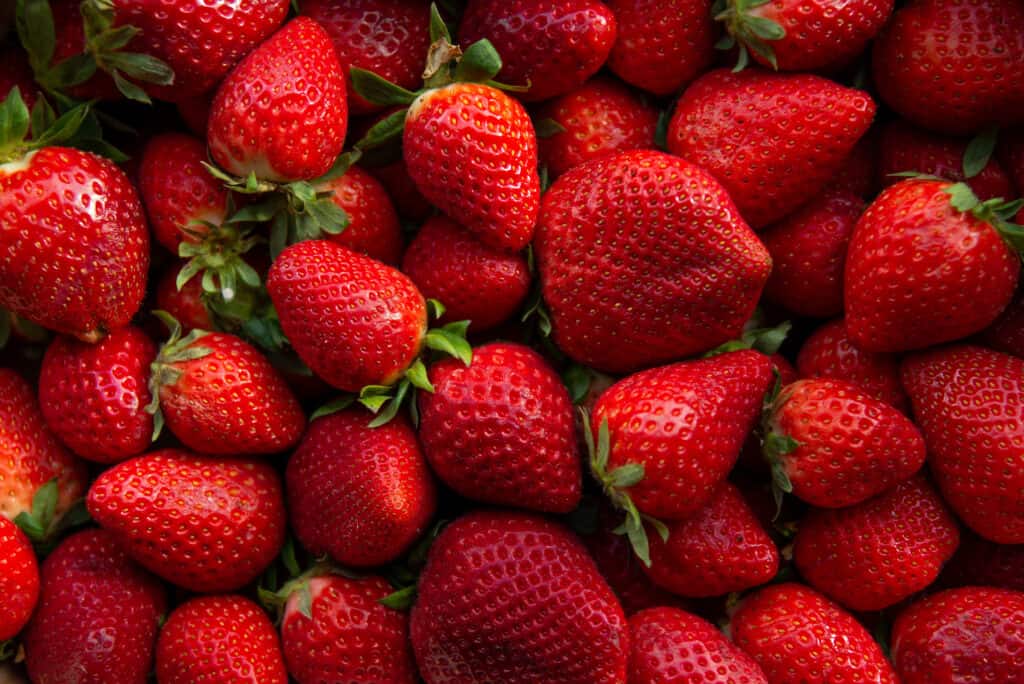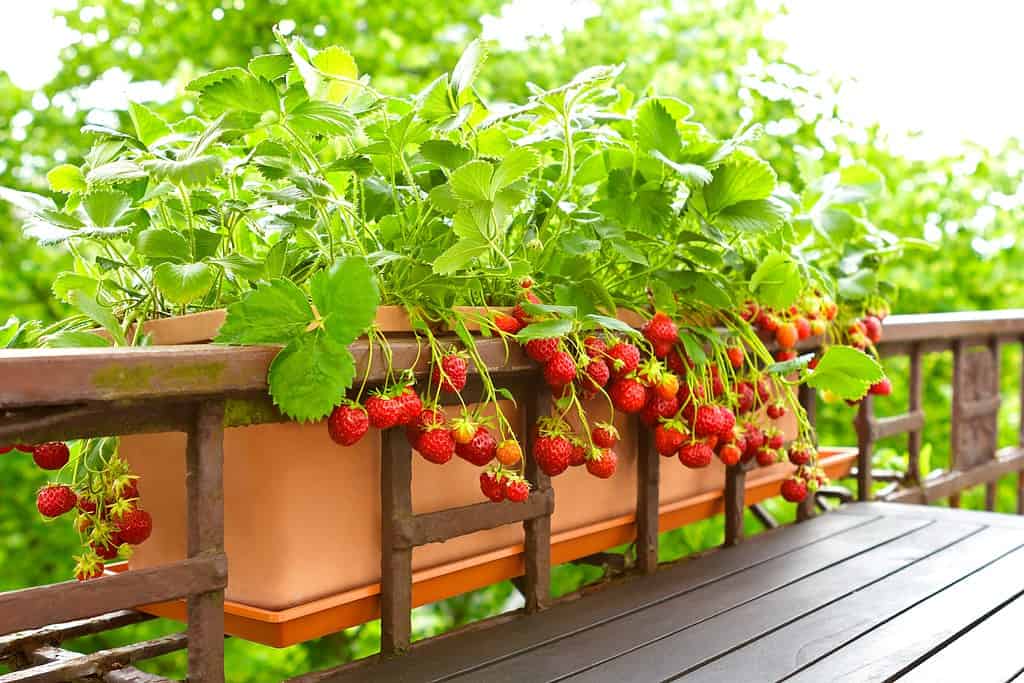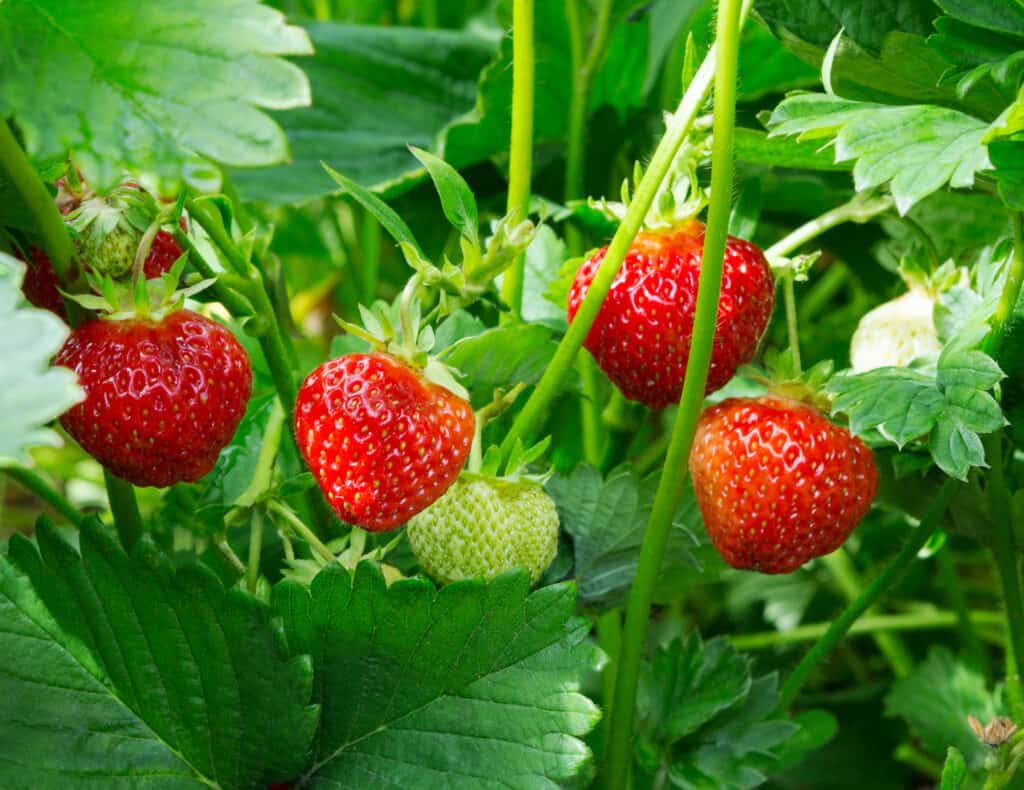Choosing to grow red and juicy strawberries in your garden is a wonderful and easy way to add some fruit to your diet. Strawberries are a quite popular fruit and they are also relatively easy to grow. When it comes to growing strawberries, they can produce a lot of fruit without the need for fancy growing equipment. If you live in Indiana and are interested in growing this fruit, then you’ll be happy to hear that it is easier than you might think! The climate is actually quite well-suited for growing strawberries.
So if you’re looking to expand your gardening skills and enjoy some delicious fruit when it comes time to harvest, then keep reading on! Below, we’ve put together a guide on the best time to plant this fruit and other helpful tips.
When Is the Best Time to Plant Strawberries in Indiana?

In Indiana, it is best to plant your strawberries in March or April — depending on when the average spring temperatures come around.
©Erika Anes/Shutterstock.com
The best time to plant strawberries in Indiana is around March or April. It is best to plant them early on in the growing season. This is because the soil is the most manageable during this time and allows the plant to establish itself in the soil. This is especially important for the first year of growth. However, it is crucial to keep in mind that strawberries are quite delicate and can be damaged from spring frosts. In order to keep them protected, it is vital for you to cover them with mulch or row covers.
It has often been noted that after an area enters its average spring temperatures that there is only a 50% chance of frost occurring. This percentage goes down all the way to 10% just two weeks later. Throughout Indiana, frost-free dates vary by region. For example, in the south all the way down to Evansville, it has been documented that the potential frost-free dates occur from April 6th through the 15th. However, in central and northern Indiana, frost-free dates often occur much later in the year. Frost-free dates typically occur here between April 26th and May 5th.
Where Is the Best Place to Plant Strawberries in Indiana?
Those of you living in Indiana will be happy to learn that strawberries will do well in soil all throughout the state. Although strawberries will grow in most soil types, they do best in well-draining soil with full sun exposure. The most important aspect to keep in mind is to choose soil that offers adequate surface drainage. You don’t want water accumulating in the soil of these fruits. However, if the only option you have is poor draining soil, you can avoid flooding the strawberries by planting them on a raised bed of about six to eight inches. This will help encourage soil drainage.
When choosing the spot in your garden, make sure that it is an area that receives six to eight hours of sunlight each day. It is also very important to avoid planting strawberries in the soil where tomatoes, potatoes, or peppers were once planted. This is because these types of plants are susceptible to soil diseases, especially Verticillium wilt. Gardeners will want to wait two to three years before repurposing this soil for growing strawberries to avoid disease.
What Varieties of Strawberries Grow Best in Indiana?

June-bearing strawberries are the best variety to grow in Indiana as they have the best chance of yielding fruit.
©Agenturfotografin/Shutterstock.com
There are three different varieties of strawberries to choose from: June-bearing, everbearing, and day-neutral. June-bearers are the type to only fruit once per season and will usually do so in the middle of the growing season. Everbearing, on the other hand, will fruit twice. This typically occurs once early on in the season and then again at the end. Finally, day-neutral strawberries will fruit multiple times throughout the growing season.
When it comes to choosing the best type for your garden in Indiana, you’ll want to go with June-bearers. June-bearers are known to do particularly well in the state. Some varieties to choose from include ‘Red Chief,’ ‘Earliglow,’ ‘Honeoye,’ and ‘Jewel.’ In comparison to June-bearers, everbearers typically do not grow well in Indiana. Day-neutrals have a possibility of growing in well-protected areas. However, the easiest to grow will tend to be the June-bearers. Overall, it is often difficult to recommend cultivars for strawberries, as they tend to be site-specific. This means that one variety of strawberries may do incredibly well in one garden and then not so well in another.
When to Harvest Strawberries in Indiana?

A ripe strawberry will be evenly red in color — not green or yellow.
©iStock.com/romiri
Strawberries are ready to harvest when they have reached their full size. They will appear red all around and be firm when you gently touch them. Unlike other types of fruit, strawberries do not continue to ripen once they are picked. This is why it is important to pick them at just the right time!
There are certain indicators that you can look for when trying to decide if your strawberries are ready to be picked:
- Color — A strawberry will be evenly red all around when they are ripe. Pay attention to their coloring when deciding whether to pick them or not. Green or yellow strawberries are not ready to be picked.
- Size — Ripe strawberries are roughly 1 to 1 ½ inches in size. However, this will depend on the specific variety that you choose to grow.
- Firmness — When a strawberry is ripe, it is firm to the touch.
7 Helpful Tips on Growing Strawberries in Indiana
1. Soil preparation is key for growing abundant strawberry fields.
Strawberries do best in mildly acidic soil. Typically, a pH of about 5.5 to 6.8. As we mentioned above, well-draining soil is also incredibly important. They will rot quickly if the soil doesn’t drain well.
2. You can reduce the amount of water your strawberries need and prevent weeds by mulching.
Making good use of mulch will help keep the soil around your strawberries moist while also preventing weeds from sprouting up. You can use a variety of different mulch including pine straw, shredded leaves, or black plastic.
3. Grow more fruit in the future by clipping blossoms to prevent fruiting.
This is a clever trick that helps gardeners gain better future yields. It is the process of removing the blossoms from the strawberries to prevent them from fruiting. This might sound counterintuitive, but this is only done during the first year. This allows the plant to focus on growing stronger and healthier roots. This in turn creates a higher yield for the next year.
4. Begin planting your strawberries as soon as the soil can be worked on in the springtime.
The earlier you plant your strawberries the better. This will result in more fruits!
5. Choose an incredibly sunny spot to plant them.
Strawberries love the sunshine. They need six to eight hours of sun exposure every day. This means that you must choose your plant site accordingly.
6. Make sure you give your strawberries plenty of room for sprawling.
Set plants at least 18 inches apart from each other. This is to make space for the runners. Additionally, you should leave at least four feet of space between the rows. Strawberries cover a lot of ground when they are growing, so it is important to give them the space to do that.
7. Do not plant the strawberries too deeply within the soil.
It is important to remember to keep the crown at the soil level. Do not fully bury it. This is because the flowers and leaves (and eventually fruit) must all be exposed to the sun. Additionally, when planting, you must make sure to make the holes wide and deep enough to keep the roots from bending.
The photo featured at the top of this post is © iStock.com/romiri
Thank you for reading! Have some feedback for us? Contact the AZ Animals editorial team.







